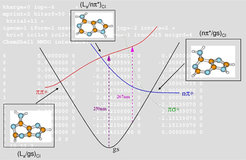Semiempirical Methods

This long-term project aimed at the development of improved semiempirical quantum-chemical methods that could be employed to study ever larger molecules with useful accuracy. This included the development of more efficient algorithms and computer programs. Applications were usually motivated by requests from experimental partners or by topical chemical problems, but they also served to explore the limits of new methods and codes.
Methodological activities include:
- the incorporation of orthogonalization corrections at the NDDO level
- the parameterization of the resulting OM approaches
- the implementation of the GUGACI method in a semiempirical context
- the implementation of semiempirical linear scaling techniques
- the derivation and implementation of analytic derivatives
- the use of genetic algorithms for semiempirical parameterizations
- the implementation of surface hopping molecular dynamics
In the past, we have applied semiempirical MNDO-type methods extensively to study the properties of fullerenes. Our emphasis has now shifted towards the investigation of the photochemistry of large organic chromophores at the OM2/GUGACI level using both static calculations and surface hopping simulations. Target systems include the nucleobases in the gas phase, in aqueous solution, and in DNA oligomers as well as fluorescent proteins, molecular motors, photochemical switches, and retinal models. In addition, semiempirical methods are used in QM/MM molecular dynamics simulations of enzymatic reactions.
